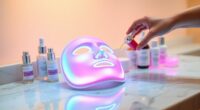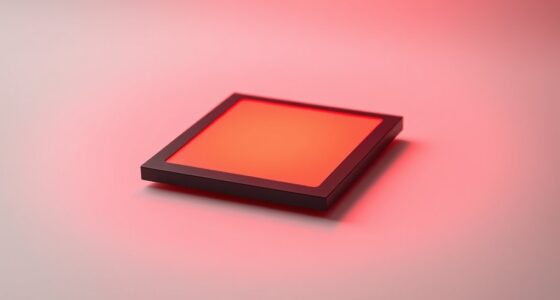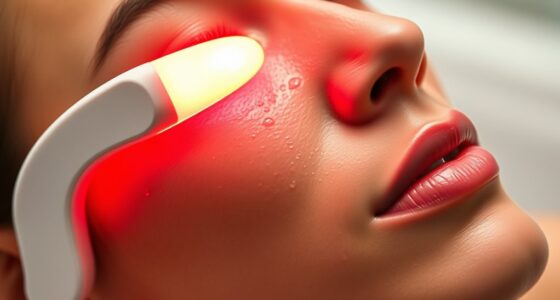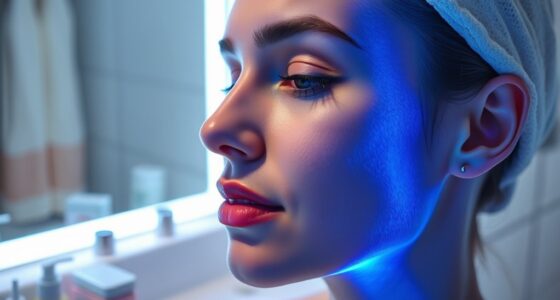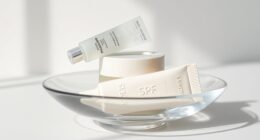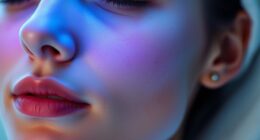Dermatologists recommend LED therapy because it's a safe, non-invasive treatment suitable for all skin types. There's no need for anesthesia, and you can get back to your day immediately. This therapy stimulates collagen production, improving your skin's texture over time, while also reducing acne-related inflammation. Different wavelengths target specific concerns, like red for anti-aging and blue for acne. Since it pairs well with other treatments, it's become increasingly popular for personalized skincare. If you're curious about how LED therapy can fit into your routine, you might find even more insights on its benefits and uses.
Key Takeaways
- LED therapy is non-invasive and pain-free, making it a comfortable option for patients seeking skincare improvements.
- It effectively stimulates collagen production, enhancing skin texture and resilience over time.
- Different LED wavelengths target specific skin concerns, such as acne, pigmentation, and aging signs.
- Dermatologists recommend combining LED therapy with other treatments for enhanced results and personalized care.
- Ongoing research supports LED therapy's efficacy for various skin conditions and its potential in anti-aging treatments.
Non-Invasive Advantages
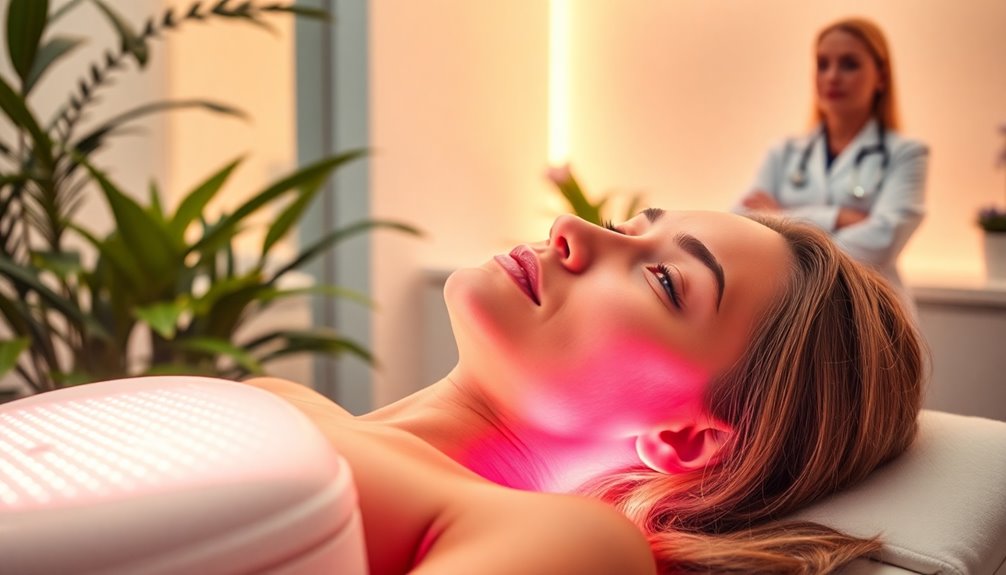
While exploring skincare options, you'll find that LED light therapy offers numerous non-invasive advantages that make it an attractive choice.
First off, the treatment is pain-free, so you won't need anesthesia or worry about skin irritation, making it perfect for sensitive skin. You can also get back to your daily activities immediately, as there's no downtime involved.
Unlike surgical procedures, LED therapy poses no risk of scarring, ensuring a comfortable experience. It's suitable for all skin types and can even enhance the effectiveness of your skincare products. Plus, it promotes natural healing by stimulating blood circulation and reducing inflammation. Additionally, this therapy stimulates collagen production, further improving skin texture and elasticity. Overall, these benefits make LED light therapy a go-to option for effective skincare without invasive hassles.
Scientific Foundations
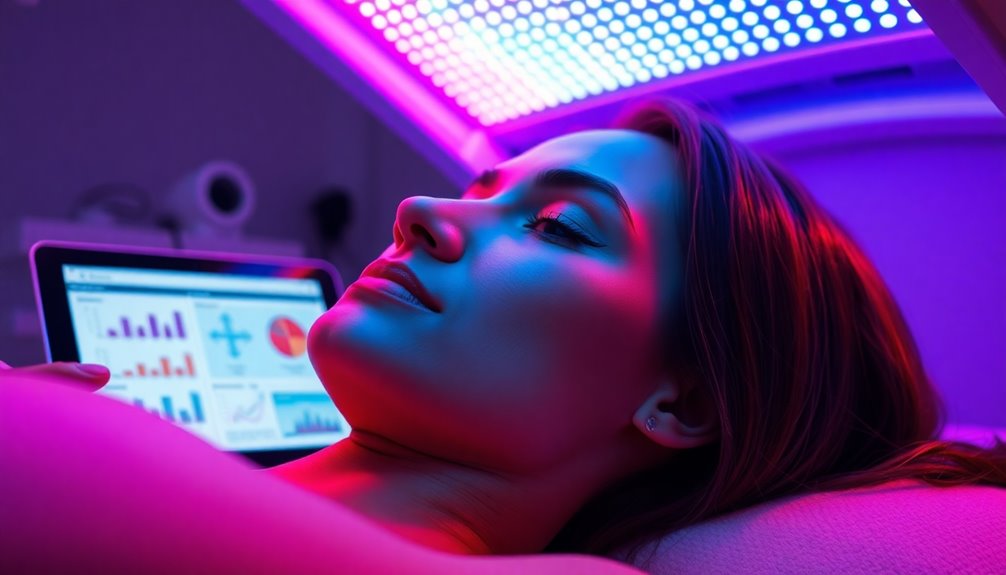
Understanding the scientific foundations of LED therapy can enhance your appreciation of its effectiveness in skincare. This therapy works through specific wavelengths of light, triggering cellular reactions that rejuvenate and heal your skin. Photobiomodulation boosts circulation, reduces inflammation, and stimulates collagen production, promoting essential cell regeneration. Each wavelength targets unique skin concerns—red light for anti-aging and blue light for acne, for instance. Clinical evidence supports its efficacy, showing significant improvements in conditions like acne and psoriasis, along with enhanced wound healing; however, variable effectiveness(variable effectiveness) has been reported across different studies. Moreover, LED therapy is safe, non-invasive, and customizable to address multiple issues simultaneously. This holistic approach not only treats symptoms but also targets the underlying causes of skin problems, making it a valuable option in dermatology.
Varieties of LED Therapy

LED therapy offers a range of varieties, each designed to target specific skin concerns effectively.
Red LED therapy stimulates collagen production, reduces inflammation, and improves circulation, helping to minimize fine lines and wrinkles. Different wavelengths trigger various skin processes, making red LED particularly effective for anti-aging benefits. Additionally, essential oils like lavender can complement the effects of red LED therapy by promoting relaxation and enhancing skin health.
Blue LED therapy focuses on acne by reducing oil production and eliminating bacteria.
Amber or yellow LED therapy alleviates redness and stimulates the lymphatic system.
Infrared LED therapy penetrates deeply, enhancing nutrient absorption and accelerating healing.
Purple LED therapy combines red and blue wavelengths for increased cell regeneration and reduced acne scars.
White or cyan LED therapy relaxes the skin while treating wounds and acne.
Lastly, near-infrared therapy boosts results by penetrating the deepest layers of skin, enhancing overall effectiveness. Each session typically lasts 20-30 minutes.
Targeted Skin Conditions
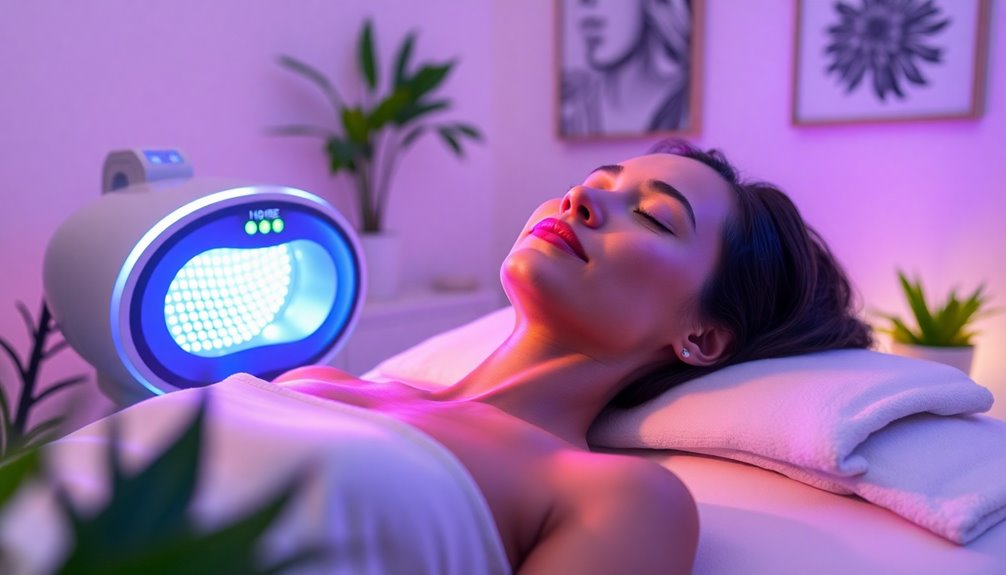
When it comes to addressing specific skin conditions, various LED therapies provide targeted solutions that can help you achieve clearer, healthier skin.
For acne vulgaris, blue light therapy effectively kills acne-causing bacteria, reduces oil production, and minimizes pore size. Combining it with red light can further soothe inflammation and promote healing. This method is particularly effective because it kills acne-causing bacteria efficiently, leading to fewer breakouts over time.
If you're dealing with psoriasis, red and near-infrared light can lower redness and alleviate plaques, enhancing skin resilience.
For anti-aging, these wavelengths stimulate collagen production, improving skin elasticity and reducing wrinkles.
While green light therapy shows promise for hyperpigmentation, more research is needed to confirm its effectiveness.
Incorporating these therapies into your skincare routine can lead to visible improvements in your skin's health and appearance.
Safety Considerations
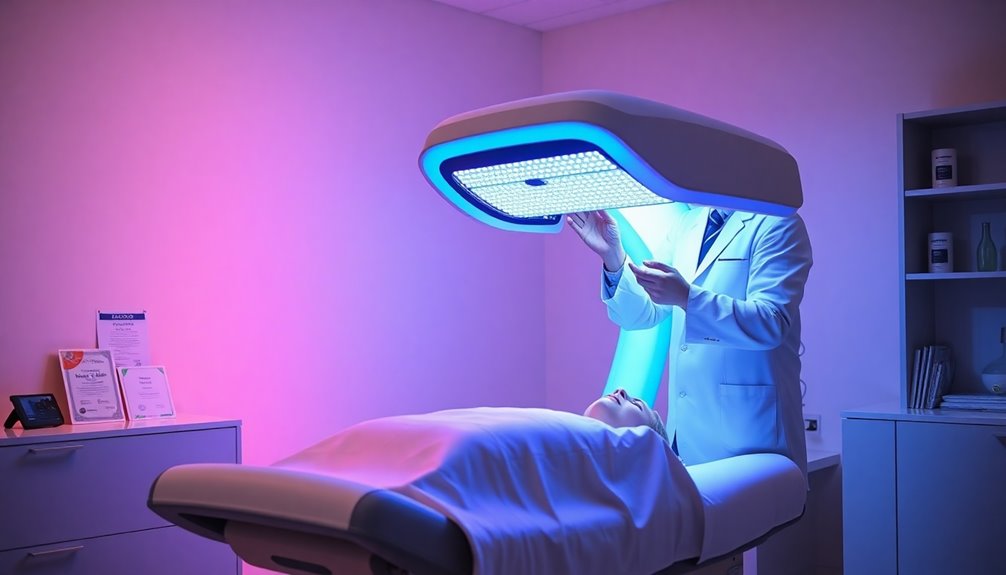
Achieving clearer skin through targeted LED therapies is promising, but it's important to consider safety measures to ensure a positive experience.
First, always use FDA-approved devices, as they've been tested for safety and efficacy. Be mindful of your skin type; sensitive skin may react poorly, so perform a patch test before your first full treatment.
Start with shorter sessions to gauge your skin's tolerance. Protect your eyes by wearing goggles, as direct exposure can lead to fatigue or damage. Understanding the different light colors and their effects can further enhance your treatment outcomes.
If you're pregnant, nursing, or on photosensitizing medications, it's best to avoid these therapies. Also, individuals with autoimmune diseases or epilepsy should consult a dermatologist before proceeding to prevent any adverse reactions.
Prioritizing safety will enhance your LED therapy experience.
At-Home vs. Professional Options
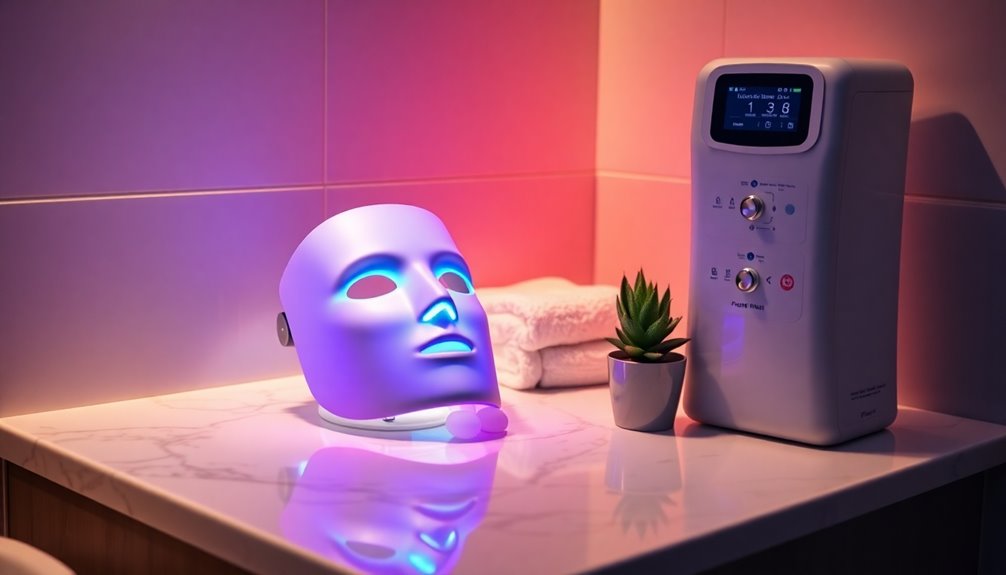
Whether you're considering at-home or professional LED therapy options, understanding the differences can help you make an informed choice.
Professional devices deliver higher intensity and precise wavelengths for deeper tissue penetration, while at-home devices offer limited power and broader wavelengths, which may not be as effective. Red light therapy has been shown to significantly reduce inflammation, enhancing the overall effectiveness of the treatment. Additionally, many professional-grade devices incorporate advanced technology to provide optimal results.
In a professional setting, trained providers monitor treatments, ensuring consistent results and immediate adjustments based on your skin's response.
Although at-home devices provide convenience, they typically cover smaller areas and may require more frequent sessions.
While you can achieve noticeable improvements with at-home options, professional therapy often leads to superior healing and faster recovery, making it a compelling choice for optimal skin rejuvenation.
Rising Popularity and Endorsements
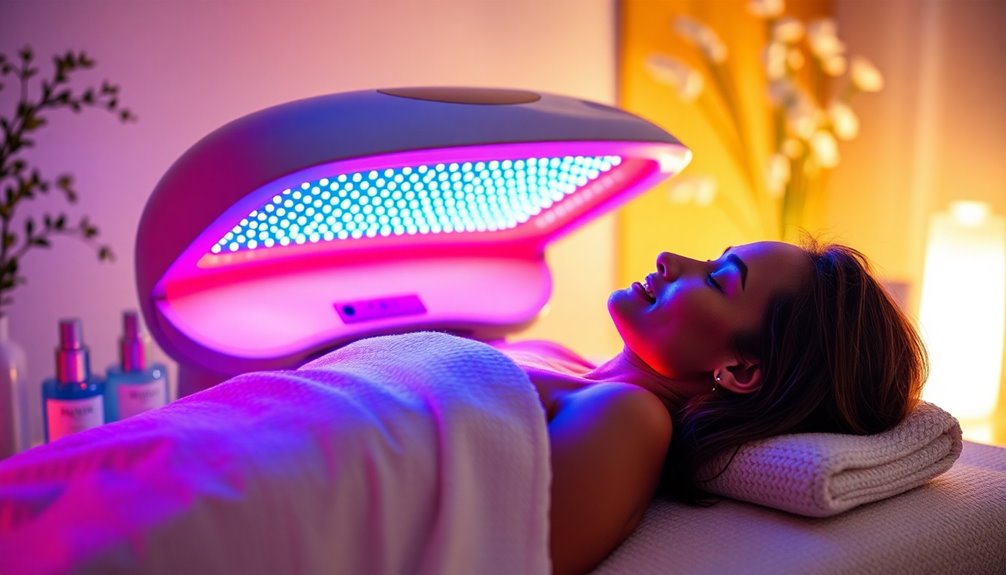
The rising popularity of LED therapy can be attributed to its impressive scientific backing and endorsements from dermatologists. Research shows that LED therapy effectively alters skin biology, treating conditions like acne, herpes, and even aiding wound healing. Systematic reviews confirm its efficacy and safety, with minimal adverse effects. Dermatologists recommend LED therapy for various concerns, including rosacea, wrinkles, and hyperpigmentation, citing significant improvements in skin health. About 90% of patients adopt these therapies at home, reflecting high satisfaction. Combining red and blue light can enhance acne treatment effectiveness by 36%. Regular use of red LEDs can help build collagen over time, further improving skin texture and resilience. Additionally, essential oils like tea tree oil have antimicrobial properties that can complement acne treatments, making LED therapy even more effective. With ongoing research, LED therapy's potential continues to expand, making it a go-to option for personalized skincare solutions.
Frequently Asked Questions
How Long Does It Take to See Results From LED Therapy?
When you start LED therapy, you might notice some immediate effects, especially with blue light for acne.
However, visible results usually take one to three months to manifest, depending on the skin condition you're treating.
For optimal outcomes, follow a consistent routine of 10 to 15 minutes, two to three times a week.
Can LED Therapy Be Combined With Other Skincare Treatments?
Yes, you can definitely combine LED therapy with other skincare treatments.
This approach enhances healing and boosts the effectiveness of treatments like chemical peels, microneedling, and facials.
By using LED light, you improve product absorption and reduce downtime.
It also helps target specific issues like acne or skin texture, making your skincare routine more comprehensive.
Is LED Therapy Suitable for All Skin Types?
Imagine you've got sensitive skin that reacts poorly to most treatments.
You'll be pleased to know that LED therapy is safe for all skin types, including yours!
It's non-invasive and free from harmful UV rays, making it ideal for delicate skin.
You can customize the treatment to address specific concerns, whether it's dryness, acne, or aging.
How Often Should I Use At-Home LED Devices?
You should use at-home LED devices three to five times a week for optimal results.
For red light therapy, aim for two to three times a week, with sessions lasting 10 to 15 minutes.
If you're treating acne, stick to three times a week.
For pain relief, daily use is best, lasting up to 30 minutes.
Always give your skin a break of at least two days between sessions to avoid overexposure.
Are There Any Side Effects Associated With LED Therapy?
Think of LED therapy as a double-edged sword—it offers benefits but can come with side effects.
You might experience mild redness, swelling, or dryness after treatment. Itching's also possible, and some may feel pain at the site.
Rarely, severe reactions like blistering or eye damage can occur, especially if guidelines aren't followed.
Always consult a dermatologist to minimize risks and ensure your skin stays healthy and happy during your treatments.
Conclusion
In conclusion, LED therapy’s non-invasive nature and scientific support make it a smart choice for skin care. With various options tailored to treat targeted troubles, you can confidently choose between at-home or professional treatments. As dermatologists endorse this glowing game-changer, its rising popularity reflects a shared commitment to achieving healthier, happier skin. So, if you’re seeking safe, satisfying solutions, LED therapy might just be the perfect path to radiant results! Furthermore, the versatility of LED therapy means it can address a range of skin concerns, from acne and hyperpigmentation to fine lines and wrinkles. By harnessing specific wavelengths of light, its effects can penetrate deep into the skin, promoting collagen production and enhancing overall complexion. As more people become aware of the LED therapy benefits for skin, incorporating this innovative treatment into your routine could lead to transformative effects that elevate not just your appearance, but your confidence as well.

